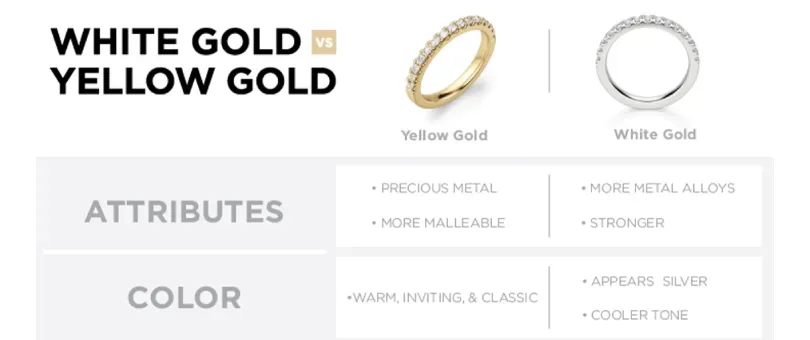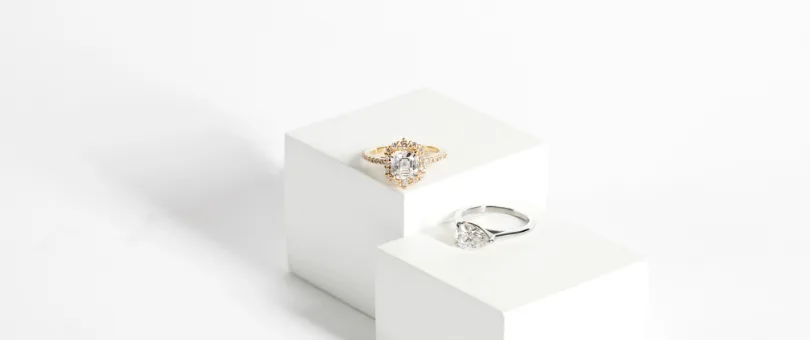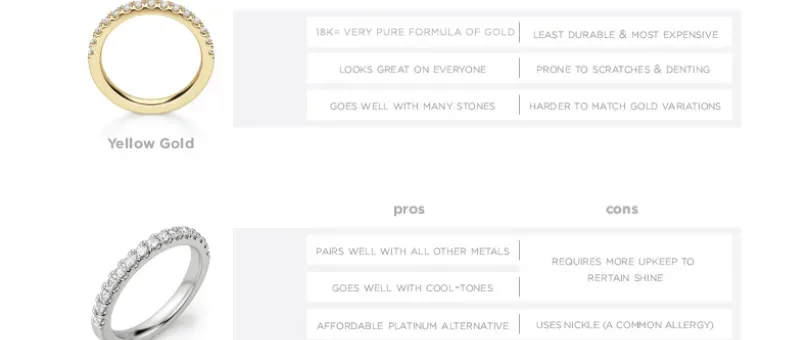White Gold vs Yellow Gold: The Difference Beyond Color!
November 6th, 2023
We’ve compared gold vs silver and rose gold vs yellow gold, but the most inconspicuous metals may be white gold and yellow gold. What sets these “golds” apart? Knowing the answer to this question is essential when shopping for gold engagement rings and wedding bands. Each metal appears differently on your skin, pairs better with different colored stones, and varies in durability and cost.

Here we will discuss the pros and cons of white gold and yellow gold and the key differences between the two, so you will understand everything you need to know about the golds before purchasing an engagement ring or any piece of fine jewelry.
White Gold vs. Yellow Gold: Key Differences

So, what’s the difference between white gold and yellow gold? Spoiler alert: they’re both wonderful options for a women’s engagement ring or wedding band and if you can’t decide, they pair nicely together too.
How White & Yellow Gold Is Made

It’s important to know how gold is made in order to understand the foundational difference between white gold and yellow gold. Gold, of any color, is made up of 24 karats. In its purest form, gold is 24K gold. Because of its malleability, pure gold must be combined with other alloys to make it durable enough for everyday wear. This is why the majority of fine jewelry comes in 10K, 14K, and 18K gold varieties. In many regions and cultures, jewelry is made in 22K, but rarely in 24k. 99.99% pure gold qualifies as 24K. Most jewelry made in 22K and 24K is plain metal and has either a few stones or flat and small stones. The majority of 22k and 24K jewelry are earrings and necklaces. Some are rings, but mostly band designs. The parts that aren’t gold come from an alloy of other metals such as copper, silver, palladium, and nickel.
Pure gold has a yellow tint, so yellow gold doesn’t need any additional elements to affect its color; however, it does need additional alloys to increase its durability. For some designs, we recommend staying away from 22k and 24k given that the metal is soft and might not be suitable to securely hold large diamonds or gemstones.
White gold typically has more metal alloys than yellow gold to give it its white color. Just like the copper alloys help make rose gold pink, white gold alloys composed of elements such as manganese, palladium, and nickel make white gold whiteish. While not an issue for everyone, many people with sensitive skin are allergic to nickel and should probably steer clear of white gold unless it is plated with rhodium. If you’re allergic to nickel or are concerned you might be, ask your jeweler for a white gold ring made without nickel alloys altogether to be safe.
Yellow & White Gold Color
Yellow gold and white gold, while both containing elements of gold, are different colors, which is perhaps the biggest difference between the two and will impact personal preference the most. Yellow gold is the color you think of when you think of gold, while white gold appears more silver than gold and has a white sheen. Yellow gold looks great on everyone and with almost every style and color of stone. It’s warm, inviting, and classic. White gold is also classic, but it has an overall cooler tone that stands out against all skin shades. White gold engagement rings pair best with stones that are also cooler in color, such as colorless diamonds, emeralds, and blue sapphires.
The number of gold karats present in the metal also impacts its color; the purer the gold, the yellower it will be. For example, 18K gold will appear to have a more yellowy-gold color than 14K gold. If you want your jewelry to match, make sure you choose either all 18K yellow gold or all 14K yellow gold, so the colors are the same. While we recommend keeping your yellow golds the same karat weight, mixing and matching different colored metals is on-trend, so you can always mix yellow gold and white gold jewelry for a fashionable look.
Durability & Maintenance
Yellow gold and white gold also vary in how durable they are, which is important to note, especially if your lifestyle involves working with your hands or being active in a way that could damage your engagement ring.
Due to its high level of gold, yellow gold is more prone to scratches and dents. However, with regular polishing and rebuffing, it can recover its brightness and beauty. Plus, because of its flexibility, your yellow gold engagement ring can easily be resized at a later date if need be.
White gold is slightly more durable than yellow gold because of the addition of nickel and other metal alloys. However, it does need just as much, if not more, maintenance than yellow gold to retain its shine. White gold is often coated with rhodium plating, which gives it the luster you want in an engagement ring or any jewelry piece. This rhodium plating not only adds luster but also additional protection from scratches and dents. However, it does wear off over time and needs to be replaced every couple of years. Most jewelers will redip white gold jewelry for free, so it’s easy to keep it lustrous and strong as long as you remember to do so.
Expense
Jewelry, especially engagement rings, can be costly, so understanding the expenses involved is crucial for savvy shoppers. When comparing white gold and yellow gold, it’s not just about color.
Consider the gold varieties: 10K, 14K, and 18K. The gold content primarily determines the price, not the color. Higher gold content means higher prices. Whether white or yellow gold, 18K is the most expensive but more prone to scratches due to its gold concentration. For affordability and durability, 14K is a popular choice.
Both white and yellow gold offer budget-friendly options. A 14K ring, regardless of color, ensures quality without breaking the bank. Compared to other metals, both gold styles are reasonably priced and widely accessible. While pricier than silver, gold offers superior quality. White gold, resembling platinum, is a cost-effective alternative with a similar appearance.
Pros & Cons of Yellow Gold

Pros
- Yellow gold looks great on everyone
- Yellow gold goes well with diamonds and warm-toned stones such as ruby, morganite, and purple sapphire.
Cons
- 18K yellow gold is the least durable and most expensive
- Variations of yellow gold are harder to match
- Yellow gold is more prone to scratches and denting and needs to be polished regularly
Pros & Cons of White Gold
Pros
- White gold has a beautiful silver-white sheen that pairs well with all other metal jewelry
- White gold is an affordable platinum alternative
- White gold goes well with cool-toned stones such as colorless diamonds, emeralds, and blue sapphires
Cons
- White gold must be replated with rhodium every few years and polished regularly
- White gold uses nickel, which is a common allergy
Is White Gold or Yellow Gold Better?
 As we said initially, both white gold and yellow gold jewelry are beautiful and reliable options for fine jewelry, including engagement rings and wedding bands. Ultimately, when comparing white vs. yellow gold, it comes down to personal preference, lifestyle, and budget.
As we said initially, both white gold and yellow gold jewelry are beautiful and reliable options for fine jewelry, including engagement rings and wedding bands. Ultimately, when comparing white vs. yellow gold, it comes down to personal preference, lifestyle, and budget.
Preference
If you wear mostly gold jewelry, you may want to choose a yellow gold engagement ring. For one, it will match the rest of your everyday jewelry, and for two, it is the color you’re likely naturally drawn to and probably prefers on your skin tone. If you wear mostly silver jewelry, you may prefer the appearance of white gold.
Remember that some colored stones go better with either white gold or yellow gold. The peachy hue of morganite looks great with yellow gold, while the cool blueness of a sapphire goes better with white gold. Similarly, a white gold setting will accentuate any yellowness in a diamond with slight color, but it will make a colorless diamond shine. If color matching is important to you, consider your engagement ring stone’s color before selecting white gold or yellow gold.
Lifestyle
Your lifestyle should also help you determine whether a white gold or yellow gold ring is right for you. If you’re a hyperactive individual, you shouldn’t select an 18K yellow gold ring because it is prone to bending and scratching and could be easily damaged. Additionally, you shouldn’t choose a white gold ring with nickel alloys if you’re allergic to nickel.
Budget
There isn’t a major difference between yellow gold and white gold engagement rings when the content of gold is the same. Be sure to comparison shop when searching for the right ring for you, and you’ll find plenty of available options within your budget.
Both white gold and yellow are timeless options for an engagement ring, so you can’t go wrong. Browse our selection of engagement rings to find the style of metal that speaks to you.
*Here at Diamond Nexus, we strive to provide valuable information while being clear and honest about our products. The Nexus Diamond™ alternative is a patented lab created diamond simulate that, among all simulants, most closely imitates the look, weight and wear of a diamond, with two exceptions – it is absolutely perfect in every way, and it costs significantly less. Price points and environmental facts expressed in this blog were taken from popular online retailers and may vary. Learn more about the environmental impact of mining by visiting our blog.

